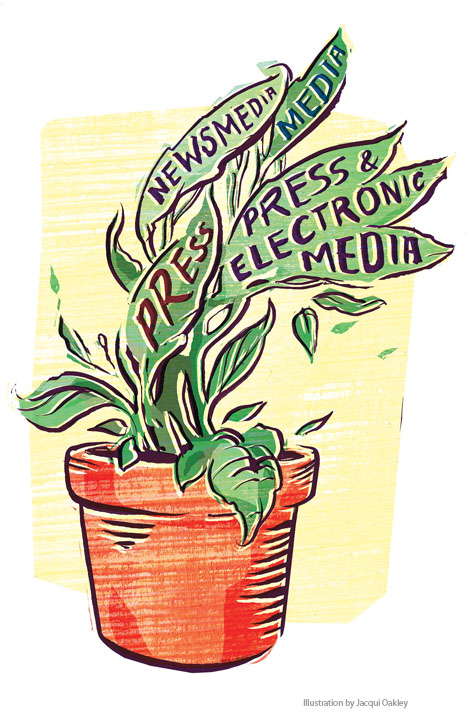
To look back at the early years of the Columbia Journalism Review is to look at how we used not just words, but the concepts around them as well. Language, of course, evolves, often as a mirror of social changes. And while we would expect to use different words—and words differently—today than we did fifty years ago, it’s also a bit surprising to see how little has changed.
Slang and idiom, as expected, are the biggest differences. CJR was not an early adopter of casual language, but “tell it like it is,” a phrase that became popular in the civil rights movement, appears on occasion in the early years. But if you now describe a boring person as “a drip,” as an article did in 1961, you might as well put on a pill-box hat.
Technology also drives our use of language, and our abandonment of same. The word “movieola,” which appeared in a 1968 article, was a corruption of Moviola, a film-editing machine; those words no longer appear in most abridged dictionaries. CJR started out referring to computers as “CPUs,” with their “tubes” called “CRTs,” then “VDTs.” Shorter than “monitors” or “screens,” but whatever.
“The press” of the first few issues became “the press and electronic media” (meaning broadcast) in the late sixties, then “news media,” then just plain “media.” Though occasionally used today, “the press” belongs to the same realm as “hell boxes,” where lead type was melted for reuse.
CJR often used the word “stodgy,” though never self-referentially! A 1962 article discussing the (mostly) minuses of the new third edition of Webster’s International Dictionary was followed in the next issue by CJR’s ruling that it was siding with the people who believed that the “new” dictionary “was aiding the dissolution of the English language.”
But most early CJR articles were written as if Edward R. Murrow were speaking to academics, not surprising given that CJR was started by a graduate school of journalism. Contractions were few; the Review spoke of itself in the third person—the day was ruled by passive voice. Imagine beginning an article today the way this one, from the pilot issue, opened: “As to a publisher’s proprietary projects, like electing a candidate or passing a few bills, the influence of today’s press is open to question. But not the battering impact of newspapers upon themselves, the ravages of self-examination and doubt.”
Yes, that was a lament over “interpretive” journalism, what today we call “spin” or “voice” or “reporting.”
Social change affects usage, and words that are not “politically correct” today sound not just archaic, but offensive. The 1959 edition of A Manual of Style (as The Chicago Manual of Style was called then) preferred “Negro,” a step away from “colored”; though it permitted “redskins,” “little brown men,” and “bushmen” as racial “epithets,” CJR mostly shied from those. “Negro” and “black” intermingled in the late sixties, and a Fall 1968 article on how to cover “racial news” even asked: “What is the appropriate word today—‘Negro’ or ‘black’?” Soon after, CJR mostly used “black,” until the late eighties, when “African-American” started creeping in.
The early CJR, like the newspaper world it reflected, was very much a white man’s world. The few women mentioned were “Miss” or “Mrs.” “Newsmen” and “men” were the pronouns, even when women were involved, well into the women’s rights movement of the seventies. That led to this ludicrous-sounding passage from a Winter 1968-69 article about “The Pill”: “Safety is not absolute but relative, varying with the individual, the severity of his condition, his age, the available alternatives.” (Emphasis added.)
In the Summer 1968 issue, CJR derided Newsweek for a passage that it said mixed fact and opinion because it “poked fun” at a female Marine’s discovery that she didn’t want to kill. It made no mention of the passage’s description of the Marine as “blond, shapely,” since that, of course, was not a matter of “opinion.” CJR added “Ms.” in the late seventies, years after Ms. magazine’s founding in 1972. (To its credit, CJR adopted “Ms.” years before The New York Times, which held out until mid-1986.)
While little of the above may be surprising, CJR also talked about issues before words for them were widely available.
In 1971, CJR wrote of the promises of cable television: “One can bring to every home two-way, broad-band communications that can provide a whole galaxy of new services,” including “facsimile reproductions” of newspapers and magazines, and “access to information banks at libraries, medical centers, etc.” (Emphasis added.) Remember, this was before the Internet as it exists now was even a gleam in Al Gore’s eye. What we might call “content” today was still “information.”
Finally, a magazine review in the early sixties seems almost prescient: “It is a curious coincidence that two of the newer magazines of serious intent are both devoted to being mere filters of information, rather than originators of it,” the article said. It gave one possible reason: “That Atlas and Current are responses to the pressing need for collection and organization of information, which the individual reader can no longer do sufficiently for himself.” Can you say “Romenesko”?
Merrill Perlman managed copy desks across the newsroom at the New York Times, where she worked for twenty-five years. Follow her on Twitter at @meperl.
